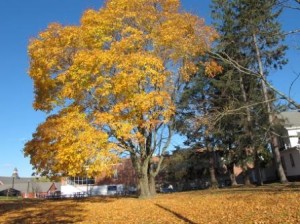Norway maple has been planted extensively as an ornamental tree and is now found invading natural areas where it often outcompetes native sugar and red maples and other deciduous trees. It has a rounded crown of dense foliage, and gray or brown bark that becomes rough and furrowed into narrow ridges as the tree ages. Its leaves typically remain green longer into the fall than other maples in Connecticut, and then turn yellow. The popular “crimson” varieties have deep maroon leaves throughout the growing season. Norway maple can be distinguished from other maples by the milky sap exuded from the end of leafstalks when they are broken off. Also, the seeds of Norway maple are flatter than seeds of sugar or red maple. Seedlings and saplings are shade tolerant and can quickly dominate the forest understory.
A. Hand Pulling:
Seedlings can easily be hand-pulled in their first year of growth.
B. Mowing/Cutting:
Large areas dominated by young seedlings can be easily controlled by mowing. Larger trees and saplings may be cut at ground level with power or manual saws. Mature individuals in the vicinity of natural areas should also be removed to remove potential seed sources.
C. Girdling:
Girdling is useful on large trees where removal of large trees is not practical. Using a hand axe, make a cut through the bark encircling the base of the tree, approximately 15 cm (6 in) above the ground. Be sure that the cut goes well into the cambium layer.
D. Herbicides:
Young seedlings are easily controlled with the herbicides below. Larger trees can be girdled by cutting through the bark and phloem all the way around the trunk. Glyphosate or triclopyr can be painted on the cut surfaces to prevent re-sprouting.
Foliar sprays for seedlings and young trees:
FINALE [glufosinate-ammonium (11.33%)]: 3 fl. oz./gal
ROUNDUP [glyphosate (41%)]: 1.25 fl. oz./gal
Cut-stump treatments for established trees:
BRUSH-B-GON [triclopyr (8%)]: Undiluted
ROUNDUP: Diluted with equal part water (1:1)
References
Kloeppel, B.D. and M.D. Abrams. 1995. Ecophysiological attributes of the native Acer saccharum and the exotic Acer platanoides in urban oak forests in Pennsylvania, USA. Tree Physiology 15(11) 739-746.
Little, E.L. 1980. The Audubon Society Field Guide to North American Trees: Eastern Region. New York: Alfred A. Knopf. Pgs. 575-576.
Webb, S.L., and C.K. Kaunzinger. 1993. Biological invasion of the the Drew University (New Jersey) forest preserve by Norway maple (Acer patanoides L.). Bulletin of the Torrey Botanical Club 120(3) 343-349
